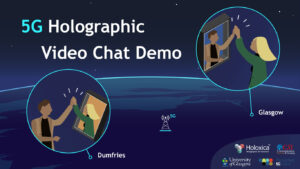World premiere at Cop26: 5G to 5G 3D videoconferencing demo
Digital Connectivity for a Green and Inclusive Future
From 2D to 3D, from tele to holo, from 4G to 5G, from flat-land to holo-land, … our horizons are shaping and shifting with increased digitalisation, tech innovation and connectivity.
Remote working due to the pandemic led to reduced commute and travel times, expenses and … a reduced ecological footprint. All of a sudden, previously smog filled cities were clear and clean. Whereas 2D videoconferencing has skyrocketed throughout the pandemic, Holoxica came up with a 3D videoconferencing prototype as a more natural, intuitive and realistic alternative. We see the world around us in 3D, it is only natural we communicate remotely in 3D, without having to wear glasses or headsets, and read that non-verbal body language that is much more difficult to detect in 2D. Perfect for a wide variety of use cases, from high powered meetings that ordinarily would require a business trip to engaging with an ageing society in rural areas to even 3D Telemedicine!
This 3D videoconferencing system will be showcased on November 11, during Cop26, from the 5G hub in the Crichton Centre in Dumfries in the South of Scotland, called the S5GConnect Dumfries hub, to the 5G hub of the Communication, Sensing and Imaging group at the James Watt School of Engineering, at the University of Glasgow. For the first time ever, we will showcase a 5G to 5G powered 3D videoconferencing! We are talking about the extreme frontlines of digitalisation, with 5G connectivity and immersive 3D holographic light field tech.
The experience will include 2-way 3D Videoconferencing between Dumfries and Glasgow, using Microsoft Azure Kinect 3D depth cameras, the fast low latency 5G network from the S5G Connect Dumfries and University of Glasgow 5G hub supported by the Scotland 5G Centre with the help of Nokia, and 3D Looking Glass Light Field displays, all running via Holoxica’s 3D Telepresence system.
Read more here.

